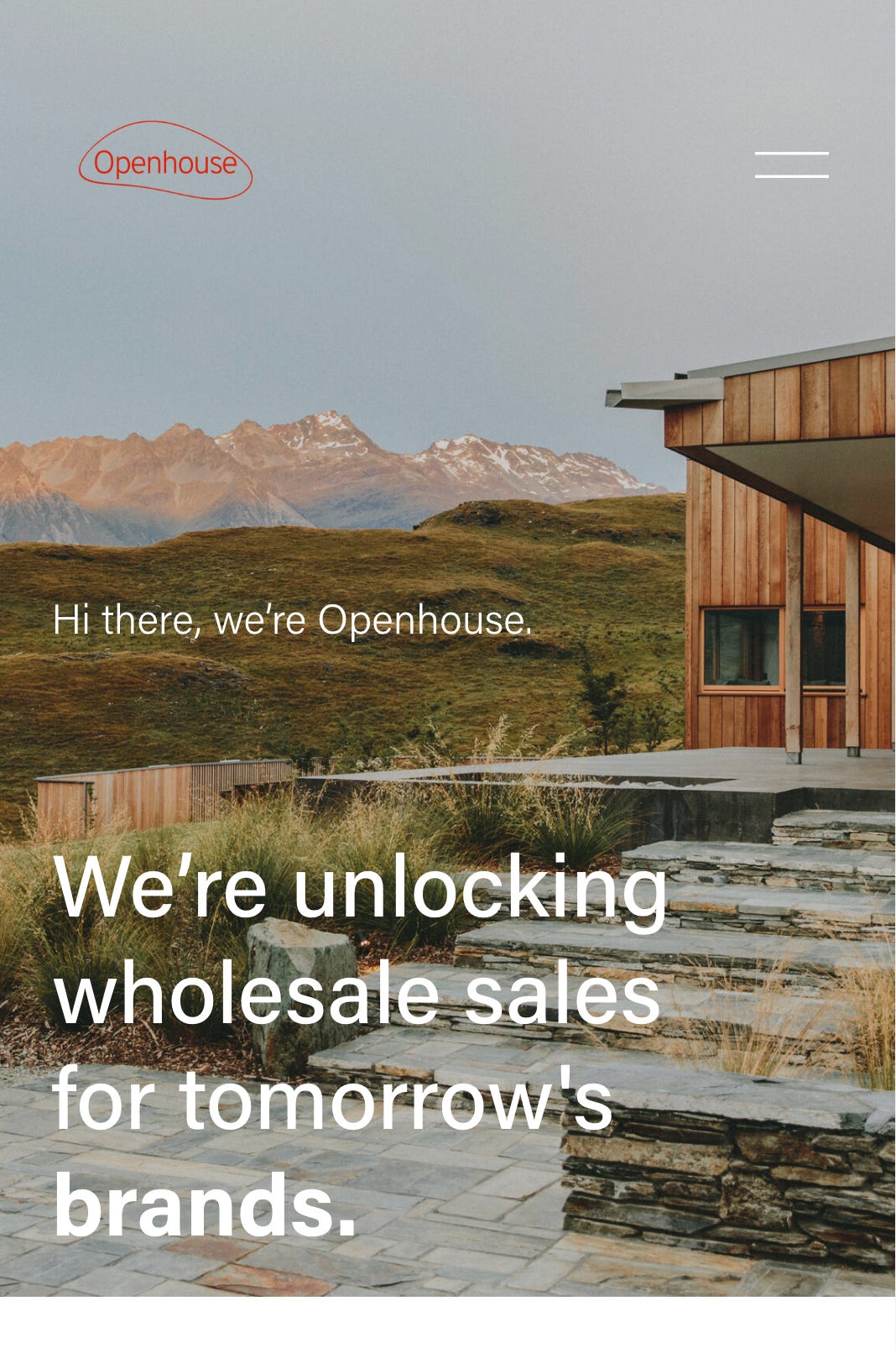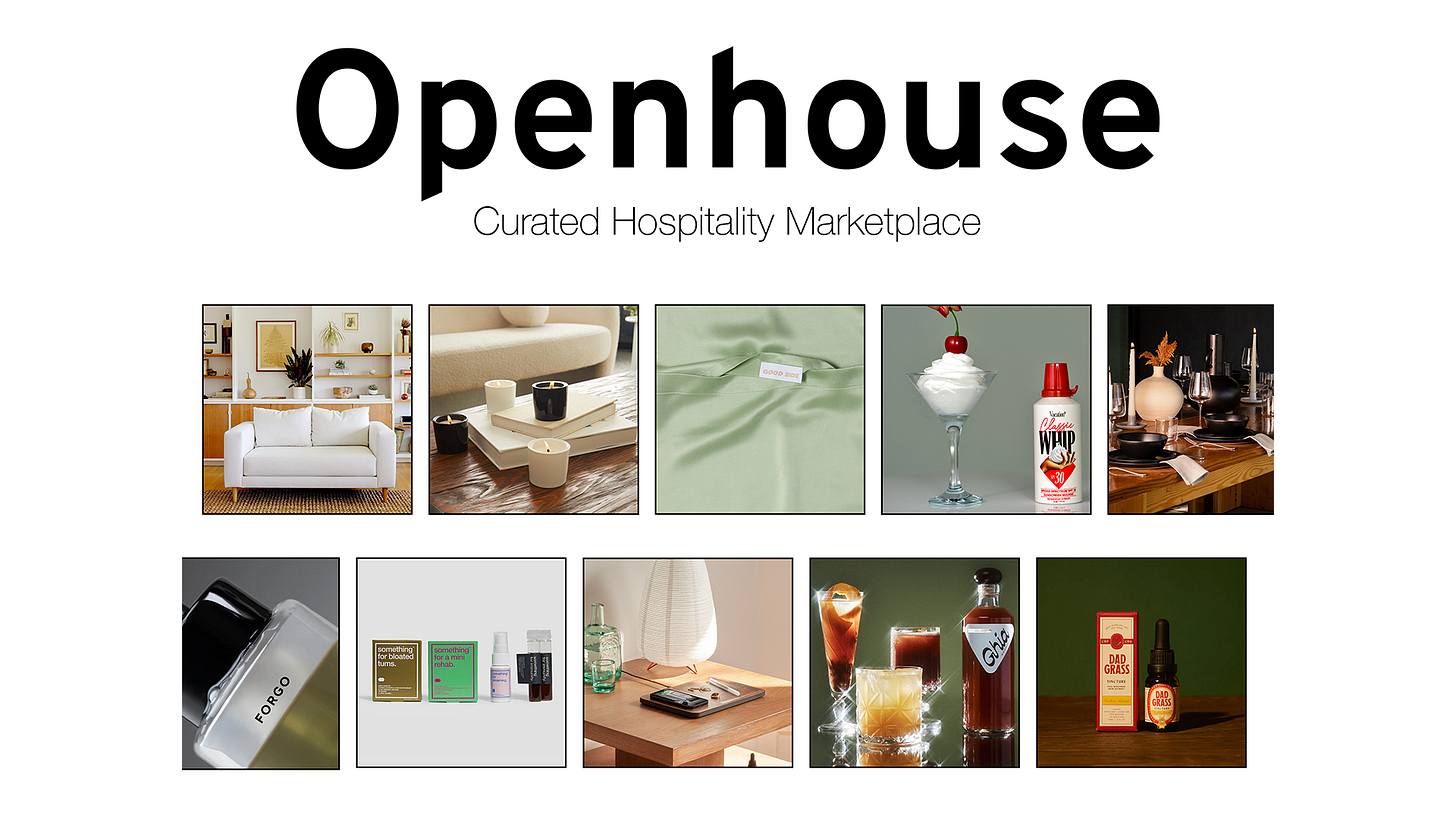Openhouse, and it's evolution from agency, to marketplace, to today.
Our first two models failed - How we reached product & founder market fit.
I launched a business in October of 2022 with a close friend and previous co-worker, Lloyd. We worked together at Public Goods - I led sales and he led Operations. There was a natural tension between our departments but a requirement that we worked well together. And, we did.
I had a list of names on my phone of other businesses I thought had great names. Buck Mason, Warby Parker, Sweetwater, etc. (my Williamsburg loop).
At Public Goods - I recommend the DTC side of the business do a test to remove our membership model/cost and see if becoming a regular e-commerce site would explode customer acquisition. The test later was named Openhouse and forfeited after a month or so. The name stuck with me for two years or so before I left to start what would become Openhouse.
The Agency
The premise was simple because I didn’t have a solid idea. If I was able to grow the B2B department at Public Goods to be that big, why can’t other brands follow a similar model? I naively thought that one brand’s product design, management style, cost/margin profile, and success in a market would mean that another brand could recreate this.
We started the business consulting - it didn’t last long. I’ve come to resent the consultancy model. It’s not scalable for the consultant because you are trading/selling your time. And the business will always need more of you since we are talking about start-ups. We burnt out quickly and felt generally that we weren’t providing any impact. They either take your advice and implement it among already limited resources, or you have to implement your own advice as a fractional piece of the business. You’re not able to spend those long hours in a state of hardcore work to push through problems because you have other clients. So you are in this constant of not being close enough to the core of any single problem to fix it. And that lack of control kills me.
The Marketplace
I used Faire and thought - this is one hell of a business. They’re unicorn status and do serious transaction volume. We hired an advisor who was ex-Faire. But what about Faire for the Hospitality Industry? Hospitality properties have OS&E (operating supplies & equipment) procurement & retail procurement responsibilities. I had seen procurement documents from operations managers and it is exactly what you’d expect.
A Google sheet with 250+ products they need from 175+ different places. Columns for volume discounts, and various shipping locations. How do they go direct for all this stuff?
Openhouse the marketplace was born. And soon - our first big mistake.
We focused on the supply side of the marketplace before demand. We onboarded 50+ brands and 1000+ products onto our Shopify store that was gated by an approval/log-in. We wanted to attach to the credibility of these awesome brands.
But as you can imagine, onboarding takes time. Contracts with each & every brand. Meetings to understand the products well. By the time our marketplace was half built 4-6 months had gone by and we were in a dash to get buyers/demand. We hired VAs, collected email lists, and started shipping sample product boxes.
True marketplaces exist between supply and demand but allow communication and transactions to flow through them. They have proprietary terms (insurance, payment terms, etc.) that make them favorable compared to going direct to the supply. This is how Faire works. Airbnb and Uber are consumer marketplaces and operate slightly differently because they both centralized supply online that used to be fractionalized (calling cabs or renting a house with a local business).
We on the other hand owned all communication - so in some regards we were more like a distributor. The problem lies in the $ side of the business. Beyond making our marketplace look cool−it had to be the same price or better than going directly to the buyer. How could we possibly do that, and make money?
Most orders we were breaking even on, some losing $ to get started. We tried to raise money, applied to Y-combinator, and ultimately fell short on all fronts. Oh well.
The final straw was understanding the product use case. We had some buyers who needed OS&E items and some who needed retail items. Beyond consolidation in order, we couldn’t find our edge on what made us uniquely valuable as compared to going direct to the brand (supply). And of course, intermediation happened all the time. We ended up with a few very loyal customers, but not nearly enough volume to pay the bills.
This space has numerous players that we know very well. In the graveyard was a business called Glimpse and Powered by Extra. Host GPO & Minoan dominate the OS&E side of the business for STRs (short-term rentals). InHouse has a newer integrated software approach (Front Desk) for guests on top of the marketplace which is awesome. And there is a new business in the space called Whence. Excited to see what they build!
The Current Business
In our efforts to fill the demand side of the business - we ended up with 7k active b2b emails. Many of which became close contacts. We found that the idea of improving the brand of the buyers we work with resonated across hospitality, retail, and wellness. The problem that became what we are solving is that branded products (merch, swag, etc.) are a fast way to spend money on decreasing your brand image. Most of the product quality is junk and the designs are never great.
The problem was two-fold. Bad product quality and bad design. So if we could tackle designing and developing our own signature product blanks and hire incredible designers to transform our brand partners’ identities - we have a repeatable business.
Which turned out to be, true! Openhouse is the most repeatable and scalable it’s ever been. We’ve shipped 45k+ units of products - and partnered with hotels, wellness studios, tech companies, media brands, and more near and far. Two models failed, a year of tests, and the willingness to try. We appreciate everyone who’s been along for the journey so far. We’re in our strongest month to date since our pivot ($70k)+ in net revenue and growing fast. We’ve added additional services such as outsourced fulfillment, Shopify stores for online sales, and e-commerce photography of our products once they’ve been produced.
We’ll be opening our pre-seed round raising $300k in March and looking to close the round in less than 1 month. I’d be happy to forward our latest investor materials to anyone interested or if you know any angel investors in your network.
Till next time!






